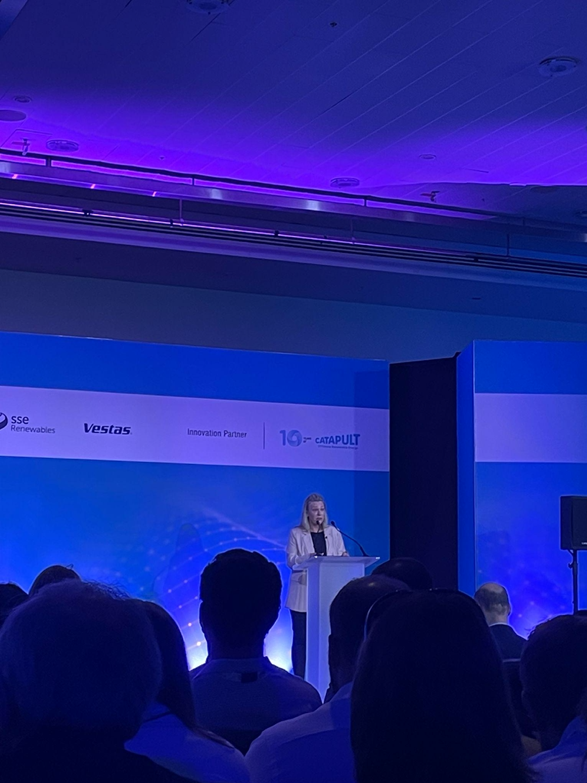Lessons from Day 2 of the Global Offshore Wind Conference
July 18, 2023
After a long but productive first day at the Global Offshore Wind Conference in London, my peers and I set out on the Elizabeth Line for a second day of attending panels and rubbing shoulders with industry experts. Our opening session was a keynote speech from Labour Party Shadow Secretary of State of Climate Change and Net Zero, Ed Miliband. Mr. Miliband’s remarks reflected the general sentiment of the diverse panelists throughout the conference: it is technically feasible to meet the UK’s goal of 50 gigawatts of offshore wind by 2030, but without proper intervention, policy and supply chain gaps could stand in the way. With his party vying to win the next UK general election, Mr. Miliband came prepared with a 5-point vision of how to close these gaps: 1) establish a new Future System Operator (similar to an independent system operator in the US) and empower it to plan for 2030 and beyond; 2) change the planning system to set time tables of months and not years, reverse the UK’s onshore wind ban, and make sure communities benefit from offshore wind projects; 3) mitigate grid delays by giving transmission operators to reduce interconnection queues; 4) enshrine clean power and net-zero as national goals under the Labour Party and ensure that regulators reflect those goals; and 5) he and a Labour Party prime minister will act with urgency to support clean energy and aim to mirror the COVID-era vaccine task force to cut down bureaucracy. In the more decentralized US, transferring all of these policies is likely impossible, but ideas for streamlining permitting and interconnection, hopefully, while preserving biodiversity, are extremely relevant.
Immediately after Mr. Miliband’s keynote, Scotland’s Minister for Energy and the Environment Gillian Martin took the stage to discuss Scotland’s floating wind potential. Ms. Martin highlighted common concerns for the need to expand supply chains, invest in ports, invest in grids, and reduce interconnection queues to meet Scotland’s ambition for 8 to 11 gigawatts of floating wind. However, her unique perspective came through when she discussed her desire for offshore wind to make a meaningful difference in peoples’ everyday lives. She proposed that people should not have to move to secure renewable jobs, that supply chain manufacturing will have enough potential to go around be sited throughout Scotland, and that a skills passport could help the clean energy sector recognize skilled workers from other areas of the energy sector. Ms. Martin’s recommendations feel especially transferable to the US, where addressing fears of fossil fuel job loss and having enough skilled workers for the clean energy transition is paramount.

Following a quick coffee break, several students attended a panel covering floating offshore wind out to 2050. The prevailing sentiment about how to bring floating offshore wind to the same level of success as fixed bottom is to encourage standardization and certainty. Panelists proposed reducing the number of concepts for floaters, standardizing the floaters, and facilitating certainty in terms of the supply chain, leasing areas, and markets.

The final panel before lunch addressed future-proofing electricity markets. Although UK and US energy markets differ, the panelists held many of the same concerns as US decision-makers. The panelists generally recommended centralized and planned transmission buildout to avoid constraints, moving away from first-come first-served to first-ready first served in interconnection queues, and reforming the market to encourage storage and flexibility in order to promote security.

For our lunch, we headed to an Indian street food-inspired food stall to chat and regain the energy we needed to finish the conference strong. After eating lunch, we visited the exhibition hall to meet with several offshore wind-related companies and learn about topics ranging from the rubber that encapsulates submarine transmission cables to multi-purpose interconnectors.
As my final panel of the day, I attended a session on sustainability in the offshore wind sector. While it was sobering to hear that the biggest challenge for sustainability is pricing and that sustainability is not currently holistically valued in auctions, it was excellent to learn from some companies setting the standard for sustainability. I hope that their sustainability methods, such as recycling the blades from turbines, sending market signals to their suppliers about wanting low carbon solutions, being living wage certified, and being fair tax market certified, can permeate the rest of the market while balancing offshore wind’s competition with fossil fuels. After a chat with one of the panelists about his career path, I rounded out my Global Offshore Wind Conference experience and headed back to our Central London apartments with new insights to carry into opportunities in clean energy policy.

About the Author
This article was written by Caitlin Flanagan, Class of 2024, Double major, Public Policy and Environmental Studies.
